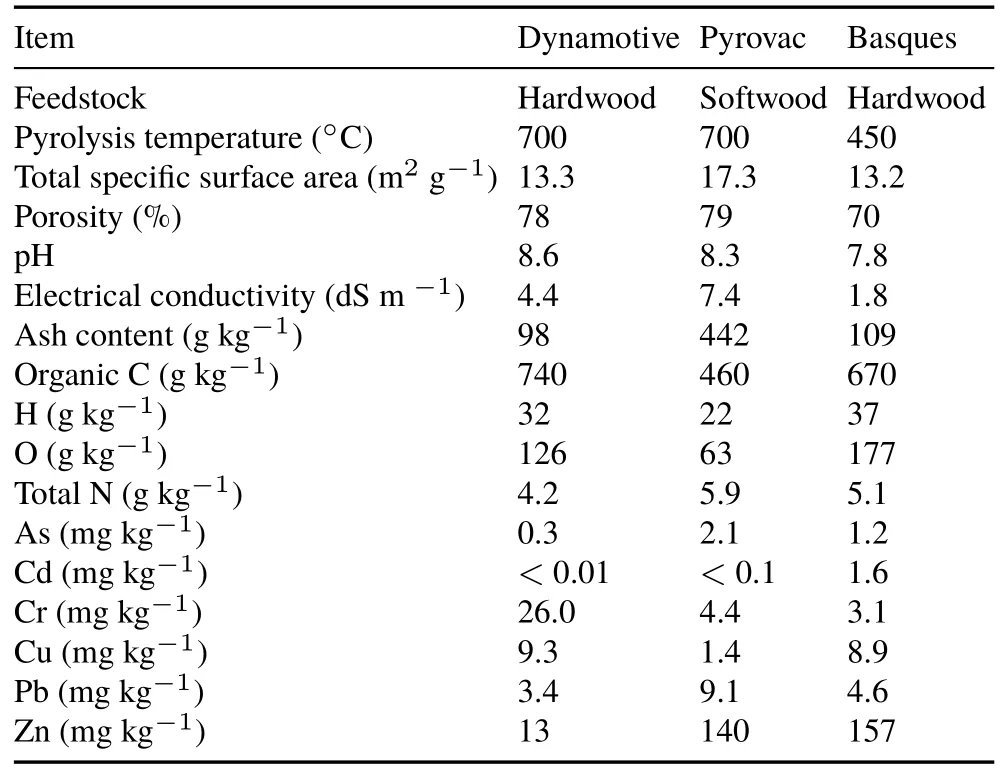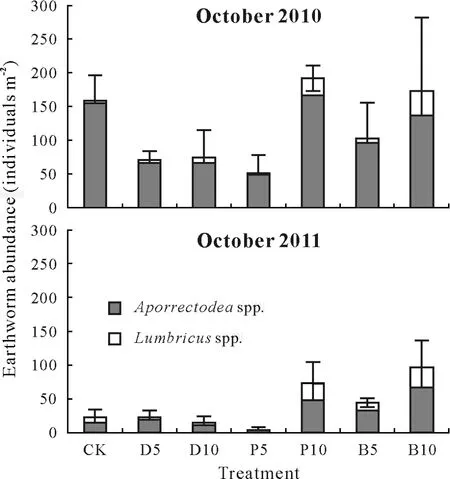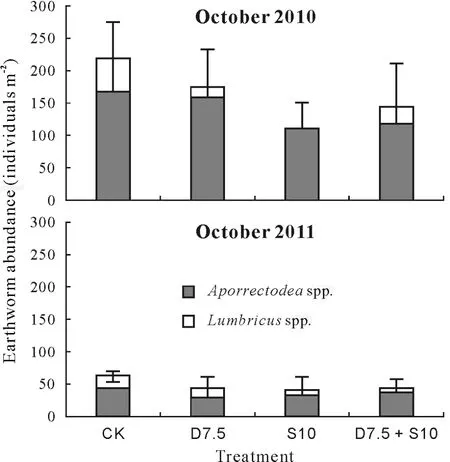Earthworm populations are stable in temperate agricultural soils receiving wood-based biochar
2021-07-16JoannWHALENHichamBENSLIMAbdirashidELMIandBarryHUSK
Joann K.WHALEN,Hicham BENSLIM,Abdirashid A.ELMI and Barry R.HUSK
1 Depar tment of Natural Resource Sciences,Macdonald Campus of McGill University,Ste-Anne-de-Bellevue,Quebec H9X 3V9(Canada)
2 Depar tment of Environmental Technology Management,College of Life Sciences,Kuwait University,P.O.Box 5969,Safat 13060(Kuwait)
3 BlueLeaf Inc.,Drummondville,Quebec J2B 5E9(Canada)
(Received September 13,2019;revised October 24,2019)
ABSTRACT The application of decomposable organic residues such as manure and crop litter is generally beneficial to earthworms.There is an emerging interest in applying biochar,a carbonaceous product of pyrolysis,to temperate agricultural soils.The slow decomposition rate of biochar,which also contains ash and combustion byproducts,could be detrimental to earthworms.The objective of this study was to describe the earthworm populations in biochar-amended soils on a dairy farm in the St.Francis River watershed,Quebec,Canada.Earthworms were collected from replicated field plots under cereal production.Site A received three wood-based biochar types at two application rates(5 and 10 t ha-1 biochar)plus an unamended control,while Site B received wood-based biochar(7.5 t ha-1 biochar),dairy cattle slurry(10 t ha-1 manure),or a combination of the biochar and manure rates plus an unamended control.Earthworms were collected by hand sorting and formaldehyde expulsion from soil pits.Three species,Aporrectodea turgida,Aporrectodea tuberculata,and Lumbricus r ubellus,were found at the sites,and Aporrectodea was the dominant genus.Biochar sources,rates,and application with dairy slurry did not affect the earthworm population,which had 52—218 individuals m-2 in 2010 and 4—96 individuals m-2 in 2011.The seasonal variation in earthworm population may be due to flooding in the spring of 2011,which apparently interfered with earthworm reproduction.The similarity in earthworm abundance and biomass in plots with and without wood-based biochar leads to the conclusion that earthworm populations are stable in biochar-amended soils in this cold,humid temperate region.
Key Words: biochar-amended soil,corn,endogeic earthworm,flooded soil,pyrolysis,woody feedstock
INTRODUCTION
Agricultural producers understand the benefits of applying organic residues,such as composted leaf litter,animal manure,vermicompost,vegetable pomace,and other residuals,to their land to maintain soil organic matter and soil fertility.Biochar is being promoted as a soil amendment that can enhance soil fertility and increase stable soil organic carbon(C)reserves because of the resistance of pyrolyzed organic C to decomposition in the short term(Josephet al.,2010).Soils amended with biochar are expected to promote microbial growth and activity,particularly in the short term,and could alter microbially mediated reactions in the soil nitrogen and phosphorus(P)cycles(Gul and Whalen,2016).The impact of biochar on soil macrofauna,such as earthworms,is less predictable.Biochar particles colonized by microorganisms could be a source of nutrition for earthworms if the particles are small enough to be ingested,since earthworms can ingest biochar particles(Lehmannet al.,2011;Domene,2016).However,biochar might change soil physicochemical properties such as moisture retention,pH,and metal concentrations,which affect earthworm survival,growth,and reproduction(Domene,2016;Sanchez-Hernandezet al.,2019).
Biochar-induced changes in soil physical properties include the modification of the soil structure through the formation of aggregates and pores,as well as water retention within biochar micropores and heat transfer processes(Bassoet al.,2013;Zhanget al.,2015;Baiamonteet al.,2019).Earthworms are unlikely to be affected by these physical changes in biochar-amended soils because they engineer the soil environment to suit their needsviaburrowing,litter fragmentation and comminution,and casting activities.Still,earthworms could respond to chemical changes in biocharamended soils.Fresh biochar contains ash,which could have elevated levels of nutritive and trace metals,as well as combustion byproducts,some of which could be toxic to earthworms(Renet al.,2018).Biochar with high sorption capacity can bind contaminants such as pesticides and metals,thereby reducing their concentrations in the soil solution and effectively detoxifying the soil environment.However,Eisenia andrei(Bouché)can bioaccumulate naphthalenetype metabolites through ingestion or dermal exposure to<0.5 mm particles of pine woodchip biochar(Prodanaet al.,2019).Most of these effects are deduced from short-term laboratory studies,and long-term field trials are needed to understand how biochar interacts with earthworms and other soil biota(Paz-Ferreiroet al.,2016).
The objective of this study was to determine if earthworm populations were affected by biochar in temperate agricultural soils amended with wood-based biochar in a cold,humid temperate region.
MATERIALS AND METHODS
Experimental sites,soil,and biochar
The experimental sites were agricultural fields on a working dairy farm in the St.Francis River watershed,Quebec,Canada(45°30′N,72°01′W,243 m above sea level).In this cold,humid temperate region,daily air temperature is from-10.6°C in January to 19.6°C in July,receiving 940 mm of rainfall plus 207 mm of snowfall each year,based on average weather data from 1981 to 2010 at Bromptonville,Quebec,Canada(Environment Canada,2019).Monthly climate conditions from April to September during the study(2010—2011)are provided in Table I.Soil is a poorly drained Podzol in the Brompton stony loam series(Lamontagne and Nolin,1997).The loamy topsoil(0—12 cm depth)contains 190 g kg-1of clay,380 g kg-1of sand,33 g kg-1of total C,and 2.3 g kg-1of total N,with a slightly acidic pH(5.9).
Three types of wood-based biochar were used in the study:i)Dynamotive,a fine powdery hardwood biochar from Dynamotive Energy Systems Corp.(Vancouver,Canada)that was pyrolyzed at about 700°C and had a pH of 8.6,ii)Pyrovac,a granular softwood bark biochar from Pyrovac Inc.(Quebec,Canada)that underwent pyrolysis at about 700°C and had a pH of 8.3,and iii)Basques,a powdery hardwood biochar produced by Charbon de Bois Basques(Quebec,Canada)by pyrolysis at about 450°C with pH 7.8.The physicochemical characteristics of these biochars are presented in Table II.

TABLE IIPhysicochemical characteristics a)of the biochar used,Dynamotive produced by Dynamotive Energy Systems Corp.(Vancouver,Canada),Pyrovac produced by Pyrovac Inc.(Quebec,Canada),and Basques produced by Charbon de Bois Basques(Quebec,Canada)
Experimental design
The experimental plots were established in May 2010 at two adjacent farm field sites(A and B)that were cultivated with a moldboard plow(15—20 cm)and disk harrowed(7—10 cm),and then a single application of biochar was broadcast by hand and incorporated to 10 cm depth with a tractordrawn disk harrow.At Site A,the experimental treatments were arranged in a randomized complete block design and included three biochar types(Dynamotive,Pyrovac,and Basques)applied at two rates(5 and 10 t ha-1biochar)plus an unamended control.The treatments were replicated in three blocks,for a total of 21 field plots at Site A.The plots were 5 m×6 m with a 1 m buffer between each plot and2 m between each block.Site A was planted with forage corn(Zea maysL.)in 2010 and mixed cereals,wheat(Triticumsp.),oat(Avena sativa),and barley(Hordeum vulgare),as a green forage crop in 2011.These crops were fertilized with inorganic NPK fertilizers plus dairy cattle slurry in the spring and fall of 2010 and 2011 at a rate of 37 400 L ha-1,according to crop-specific provincial recommendations(CRAAQ,2010).Dairy cattle slurry contained 11%dry matter with 36 g kg-1of total N,13 g kg-1of NH4-N,18 g kg-1of total P,and 29 g kg-1of total K.No insecticides,fungicides,or bactericides were applied during the study.In 2010,broadleaf weeds and grasses that compete with corn were controlled with a post-emergence application of CallistoTM(Syngenta,Basel,Switzerland)that delivered 0.3 L ha-1of the active ingredient(a.i.)mesotrione plus Primextra II MagnumTM(Syngenta)containing 3.5 L a.i.ha-1of atrazine and S-metolachlor.No herbicides were applied to the green forage crop in 2011.

TABLE IMonthly weather data from April to September during the study(2010—2011)and the 30-year average data in 1981—2010 at Bromptonville,Quebec,Canada
Site B had four treatments in a randomized complete block design with three replicates.The treatments were:biochar(Dynamotive)at 7.5 t ha-1,dairy cattle slurry at 10 t ha-1,a mixture of biochar(Dynamotive,7.5 t ha-1)plus dairy cattle slurry(10 t ha-1),and an unamended control.Plots were 5 m×6 m with a 1-m buffer between plots and a 2-m buffer between blocks.Site B was planted with the same crop sequence as Site A(forage corn in 2010 and mixed cereals as a green forage crop in 2011),but the fertilization practices differed.Plots with biochar and the unamended control received inorganic NPKfertilizer,and those receiving dairy cattle slurry received no inorganic NPKfertilizer.Weed and pest control was the same as that at Site A.
Earthworm sampling and identification
Earthworms were collected on October 5,2010 and October 2,2011.Soil was excavated from a 0.25 m×0.25 m×0.25 m pit located near the center of each plot(21 plots at Site A and 12 plots at Site B)and transferred to a 37-L RubbermaidTMcontainer that was covered with a perforated,tight lid.We poured a diluted 0.5%formaldehyde solution into the pit,making sure it was fully saturated.Deeperdwelling earthworms that emerged up to 15 min after the solution drained from the pit were collected with forceps and transferred into labeled 120-mL specimen cups containing 5%formalin.The soil in the containers was stored in an unheated building at about 10°C for up to two days while hand sorting was done.The soil-dwelling earthworms were placed in specimen cups with 5%formalin.Intact worms with a fully developed clitellum were identified to the species level(Reynolds,1977),while juveniles and fragments with a head were designated asAporrectodeaspp.orLumbricusspp.based on pigmentation.Earthworms were dried(60°C for 48 h),weighed,and ashed at 500°C for 4 h to determine the biomass on an ash-free dry weight basis.Earthworm abundance and biomass were calculated as individuals m-2and g ash-free dry weight m-2,respectively.
Statistical analysis
The effects of biochar type and application rate on earthworm abundance and biomass were determined using analysis of variance(ANOVA),following the procedure of Piephoet al.(2006)to accommodate the unamended controls in the 3×2 factorial structure of Site A.Earthworm abundance and biomass were compared among treatments at Site B with one-way ANOVA.Data were analyzed separately for the 2010 and 2011 seasons since the climatic conditions and cropping practices differed each year.The normal distribution of the residuals was verified using the UNIVARIATE procedure in the SAS statistical software(version 9.2,SAS Institute Inc.,Cary,USA).
RESULTS AND DISCUSSION
Adult earthworms were identified to the species level asAporrectodea turgida(Eisen),Aporrectodea tuberculata(Eisen),andLumbricus rubellusL.,all of which are common in Quebec,Canada.The earthworm family Lumbricidae found in North America was introduced by European settlers,and temperate agroecosystems typically support 2—5 earthworm species(Whalen and Fox,2007),so the presence of three species in this study is consistent with previous observations.More than 75%of the earthworms collected during this study were juveniles,which can be identified to the genus level,but not to the species level.Considering this,we presented the sum of all individuals belonging to the generaAporrectodeaandLumbricusasAporrectodeaspp.andLumbricusspp.,respectively.
TheAporrectodeaspp.were numerically dominant at Sites A and B in both years,which is expected given the widespread distribution of the genusAporrectodeain agroecosystems of eastern Canada(Reynolds,2010).At Site A,there were 52—193 earthworms m-2in 2010 and 4—96 earthworms m-2in 2011(Fig.1).Site B also had a numerically larger earthworm population in 2010(111—218 individuals m-2)than in 2011(41—63 earthworms m-2)(Fig.2).Earthworm populations at Sites A and B were similar in size to those reported in other agricultural fields in Quebec,Canada,which commonly have 46—422 earthworms m-2in the fall sampling period(Whalen,2004;Eriksen-Hamelet al.,2009;Whalenet al.,2012;Kerneckeret al.,2015).However,earthworm populations were not affected by biochar type or application rate(Site A),and they did not differ among the biochar and dairy cattle slurry treatments(Site B).

Fig.1 Earthworm abundance in agricultural field plots(Site A)receiving no(control,CK)and 5 and 10 t ha-1 wood-based biochar Dynamotive,Pyrovac,and Basques(D5,D10,P5,P10,B5,and B10,respectively)in October 2010 and October 2011 in the St.Francis River watershed,Quebec,Canada.Values are means with standard errors shown by vertical bars(n=3).See Table II for details of the biochar types used.

Fig.2 Earthworm abundance in agricultural field plots(Site B)receiving no(control,CK)and 7.5 t ha-1 wood-based biochar(Dynamotive,D7.5)and/or 10 t ha-1 dairy cattle slurry(S10)in October 2010 and October 2011 in the St.Francis River watershed,Quebec,Canada.Values are means with standard errors shown by vertical bars(n=3).See Table II for details of the biochar used.
The biomass ofAporrectodeaspp.was greater than the biomass ofLumbricusspp.in both years,showing the same numerical decline at Sites A and B between the 2010 and 2011 seasons(Tables III and IV).The biomass estimates were greater when large-bodied species likeLumbricus terrestrisL.andAporrectodea longa(Ude)were part of the earthworm community,so it is not possible to compare earthworm biomass among agricultural sites with different earthworm species composition.Earthworm biomass was not affected by biochar type or application rate(Site A),and it did not differ among the biochar and dairy cattle slurry treatments(Site B).
In temperate agroecosystems,the size of earthworm population is affected strongly by weather conditions.For instance,the decline in earthworm numbers from one growing season to the next is a consequence of dry conditions during the summer months(Whalenet al.,1998;Whalen,2004),which reduces earthworm survival and reproduction(Holmstrup,2001).There was no drought during this study,but there was nearly 200 mm more rainfall during the 2011 growing season than expected in this region(30-year average from 1981—2010)(Table I).Sites A and B were flooded during April—May in 2011 and were periodically waterlogged during August in 2011.Earthworms can tolerate temporary flooding events,but prolonged inundation causes mortality(Fox and Taylor,1955);recurring inundation interferes with earthworm reproduction because cocoons that hatch after the floodwater recedes must grow from juveniles to sexual maturity and reproduce before the area floods again in order to sustain the population(Kloket al.,2006).In temperate agroecosystems,the peak reproductive period forAporrectodeaspp.andLumbricusspp.is in May—June(Whalenet al.,1998),whileAporrectodea turgidamay reproduce in July—September in Quebec,Canada(Reynolds,2010).Although we did not evaluate earthworm reproduction by collecting and measuring their cocoons,we hypothesized that flooding during the earthworm reproduction periods in April—May and August were responsible for the decline in earthworm populations and biomass between the 2010 and 2011 growing seasons.
When applied as an agricultural amendment,biochar is expected to boost soil fertility and crop yield in tropical agroecosystems,but it is less likely to have these effects in temperate agroecosystems(Jefferyet al.,2017).In addition,biochar-induced changes in soil physical,chemical,and biological properties decline with time due to biochar oxidization and accumulation of exchangeable H+from the soil solution within weeks to months of its application(Gulet al.,2015).The evaluation of Site A during the 2011 growing season,1-year after wood-based biochar was applied,showed no difference in the soil water-holding capacity,runoffvolume,or infiltration rate of the biochar-amended and unamended plots.However,increasing the biochar application rate increased the stability and nutrient contents of microaggregates(Sachdevaet al.,2019).Soil pH was similar in the control plots(pH 5.8—5.9)and the biochar-amended plots(pH 5.6—6.0)of Sites A and B and should not affect earthworm populations adversely given their tolerance to soil pH from 4 to 7(Kloket al.,2007).The cation exchange capacity of the control plots(9.35—10.1 cmolckg-1)was consistent with the biochar-amended plots(9.02—10.0 cmolckg-1),but slightly less than the plots that received dairyslurry alone or in combination with the biochar Dynamotive at Site B(10.8—11.3 cmolckg-1).The biochar contained part per million levels of the metalloid As and trace metals Cd,Cr,Cu,Pb,and Zn(Table II).The biochar was applied and mixed with soil to a depth of 15—20 cm by moldboard plowing,which effectively diluted metal(loid)contaminants in a soil mass of approximately 2.24×106kg soil ha-1,the weight of a hectare furrow slice.Based on the measured metal(loid)concentrations(Table II),the maximum biochar application rate of 10 t ha-1would increase the metal(loid)concentration by<1 mg kg-1soil.Biochar may contain other potentially toxic compounds,such as polycyclic aromatic hydrocarbons generated during the combustion process(Wanget al.,2017),but these were not evaluated.Due to the good buffering capacity of our non-contaminated agricultural soil and the relatively low biochar application rate,we did not expect an accumulation of metal(loid)s or other toxic compounds.However,it would be important to document their actual concentrations in the soil for the protection of environmental and human health(CCME,2007).

TABLE IVBiomass of Aporrectodea spp.and L umbricus spp.in agricultural field plots(Site B)receiving no(control,CK)and 7.5 t ha-1 wood-based biochar(Dynamotive a))and/or 10 t ha-1 dairy cattle slurry in October 2010 and October 2011 in the St.Francis River watershed,Quebec,Canada
Agricultural practices such as tillage can affect earthworms dramatically(Chan,2001),and it may take several weeks for earthworm populations to recover from soil disturbances such as compaction and tillage(Capowiezet al.,2012;Briones and Schmidt,2017).In this study,all the plots were tilled with the same equipment and at the same time,so we cannot attribute changes in earthworm populations to the tillage practice.It seems unlikely that the biochar-induced changes in soil microstructure documented by Sachdevaet al.(2019)would affect earthworm populations.Many pesticides are deleterious to earthworms(Stanley and Preetha,2016),but no insecticides or fungicides that could be directly toxic to earthworms were applied during this study.Herbicides are not toxic to earthworms,but may cause a temporary increase in earthworm biomass when dead plant biomass accumulates belowground or on the soil surface(Zalleret al.,2014).It is improbable that a single post-emergence herbicide application to corn in June 2010 could explain the seasonal variation in earthworm populations,which were measured after crops were harvested in October 2010 and October 2011.Finally,the earthworm population size increases when more organic substrates are available for consumption(Abail and Whalen,2018).Crop yield was similar in biochar-amended and control soils in this study(on average,15.3 t dry weight ha-1of corn forage in 2010 and 7 t dry weight ha-1of mixed cereal forage in 2011,unpublished data),suggesting that earthworm access to organic substrates from crop residues was not affected by biochar treatments.It appears that the biochar application rate was too low to induce a long-term change in soil and crop parameters that could affect earthworm populations,one to two years after the wood-based biochar was applied.Since biochar application rates were selected based on agronomic and economic considerations,it seems unlikely that farmers in this region would apply higher rates of biochar as a soil amendment.
CONCLUSIONS
Wood-based biochar,applied as a soil amendment alone or in combination with dairy cattle slurry,had no effect on earthworm populations in agricultural fields on a dairy farm in the cold,humid temperate region of southern Quebec,Canada.The agronomic rates of biochar applied to this farm had minimal impacts on soil physical and chemical properties and did not affect crop yields.Earthworm populations were more likely to respond to environmental stress,such as flooding and other unfavorable weather conditions,than to biochar application in agricultural soils of cold,humid temperate regions.
ACKNOWLEDGEMENTS
BlueLeaf Inc.purchased the biochar and funded the field experiment.We thank Vanita Sachdeva,Sasha Rodrigues,and Bethany Templeton for technical assistance in the project,which was supported by a Collaborative Research Grant(No.CRDPJ 398181-10)from the Natural Sciences and Engineering Research Council of Canada(NSERC).
杂志排行
Pedosphere的其它文章
- Soil properties,grassland management,and landscape diversity drive the assembly of earthworm communities in temperate grasslands
- Earthworm community development in soils of a reclaimed steelworks
- Community structure of Lumbricidae in beech woodland of the Bieszczady National Park,Southeast Poland
- Earthworm contributions to soil nitrogen supply in corn-soybean agroecosystems in Quebec,Canada
- Earthworm functional groups are related to denitrifier activity in riparian soils
- Impacts of wetting-drying cycles on short-term carbon and nitrogen dynamics in Amynthas earthworm casts
